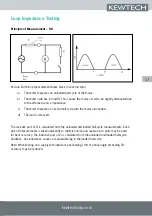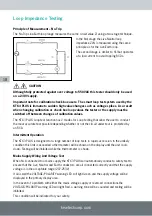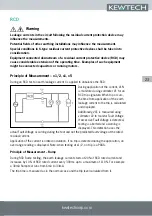
kewtechcorp.com
23
kewtechcorp.com
RCD
Warning
Leakage currents in the circuit following the residual current protection device may
influence the measurements.
Potential fields of other earthing installations may influence the measurement.
Special conditions in S-type residual current protective devices shall be taken into
consideration.
Equipment connected downstream of a residual current protective device (RCD) may
cause considerable extension of the operating time. Examples of such equipment
might be connected capacitors or running motors.
Principle of Measurement – x1/2, x1, x5
During an RCD test an earth leakage current I is applied to unbalance the RCD.
During application of the current, VLN
is monitored using voltmeter V1 for an
RCD trip signature. When trip occurs,
the time from application of the earth
leakage current to the trip is calculated
and displayed.
Additionally, VLE is measured using
voltmeter V2 to monitor Fault Voltage.
If excessive Fault Voltage is detected,
testing is aborted and a warning is
displayed. This detection uses the
actual Fault Voltage occurring during the test and not the predicted fault voltage at the rated
residual current.
Application of the current is limited in duration. If no trip is detected during the application, an
over range reading is displayed. Note: when testing at x1/2, no trip is a PASS.
Principle of Measurement – Ramp
During RCD Ramp testing, the earth leakage current starts at 20% of RCD rated current and
increases by 10% of RCD rated current every 300ms up to a maximum of 110%. For example
a 30mA Ramp test runs from 6mA to 33mA.
The trip time is measured as in the normal case and the trip level calculated from it.
























